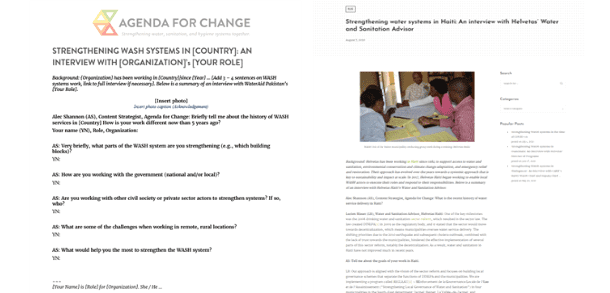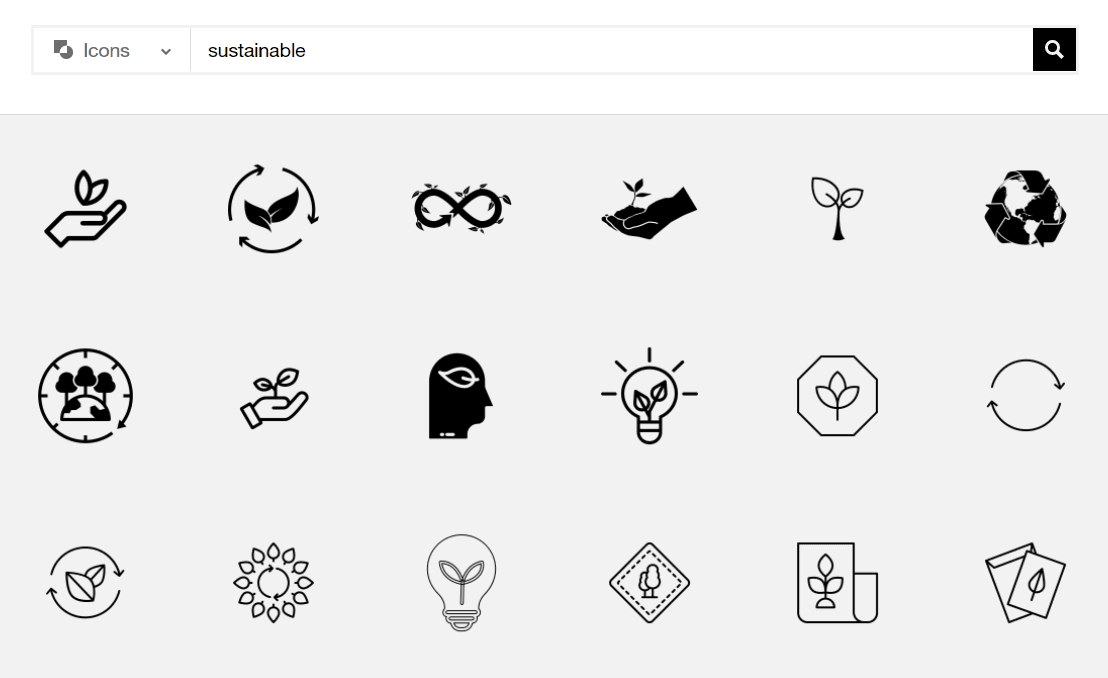Une collaboration efficace ne peut se faire sans tenir compte de l'inclusivité. Chez Agenda for Change, nous avons réalisé que changer les systèmes et influencer le secteur de l'eau, de l'assainissement et de l'hygiène (WASH) nécessitera une communication différente. Ci-dessous, nous partageons certains de nos outils quotidiens préférés que nous utilisons pour faire progresser les communications WASH inclusives.

Une façon à l'ancienne de communiquer - une machine à écrire noire brillante avec des lettres dorées, chargée d'une seule feuille de papier blanc (Florian Klauer via Unsplash).
Par Alec Shannon, Coordinateur adjoint d'Agenda for Change
Dans ma première article de blog dans cette série, j'ai partagé cinq étapes pratiques que le Secrétariat du Programme pour le changement a prises au cours de la dernière année pour rendre nos communications et le partage des connaissances plus inclusifs, y compris des accommodements comme la traduction, l'interprétation et la facilitation professionnelle. Dans la seconde article de blog, J'ai partagé quelques exemples de commentaires que nous avons reçus après chacun de nos événements virtuels l'année dernière et comment nous y avons répondu, ainsi que nos plans pour l'avenir. Ceci nous amène à maintenant: la troisième et dernière partie de notre série «Communiquer pour collaborer», consacrée aux outils.
Par outils, j'entends les services virtuels et les marchés que nous utilisons chaque jour pour rendre notre travail plus inclusif, plus beau, plus sonnant et plus efficace. Nous travaillons en permanence sur des moyens de partager les connaissances entre les publics avec un contenu court (`` grignotable '') et engageant (`` collant '') qui peut susciter l'intérêt pour Agenda for Change et les ressources des membres, des événements, des opportunités d'emploi, etc. une variété d'outils pour concrétiser nos idées créatives. Beaucoup de ces outils sont gratuits; s'ils ne le sont pas, j'ai noté ci-dessous combien ils coûtent.
Sans plus tarder …
Plus inclusif
La traduction de la langue – DeepL
Le service de base est gratuit, avec des limitations sur le nombre de caractères et le volume de traductions proposées. Les forfaits payants commencent à 7 USD / mois et incluent une traduction de texte illimitée ainsi que la possibilité de traduire 5 à 100 fichiers entiers (formats .doc, .ppt, .txt) par mois.
Je suis surpris du nombre de personnes avec lesquelles je travaille qui n'ont pas entendu parler de DeepL, car c'est vraiment un service de traduction incroyable qui surpasse de loin ceux offerts par Google Translate ou Microsoft Translator. L'outil de traduction DeepL correspond avec précision au ton et à la grammaire des déclarations traduites extrêmement rapidement et dans plus de 12 langues, ce qui facilite la traduction d'e-mails, de newsletters et de documents pour les personnes qui préfèrent lire dans une autre langue que la vôtre. Astuce: ajoutez un lien vers votre traduction DeepL en haut de vos e-mails, afin que vos collègues puissent rapidement cliquer et lire ce que vous avez envoyé dans leur navigateur (voir ci-dessous).

Un exemple de la façon d'ajouter un lien vers la traduction DeepL dans les e-mails. Une partie de mon e-mail s'affiche en haut, en anglais - ce texte a été collé dans la boîte `` Traduire de l'anglais '' de DeepL (côté gauche) et j'ai sélectionné `` Traduire en espagnol '' (côté droit). Ensuite, j'ai cliqué sur le bouton «Partager la traduction» en bas à droite. Cela crée un lien que vous pouvez saisir dans votre e-mail d'origine. Une fois que votre collègue clique sur le lien, DeepL s'ouvre dans son navigateur et traduit automatiquement votre texte enregistré. Dans cet exemple, mon e-mail en anglais a été traduit en espagnol
Interprétation de la langue en direct - Zoom sur le webinaire et la réunion
Le plan Standard Pro Meeting (2 utilisateurs) + module complémentaire de webinaire est de 55 USD / mois; les prix varient selon le plan.
Jusqu'en 2020, la plupart des événements, réunions et webinaires de l'Agenda pour le changement se tenaient uniquement en anglais. L'interprétation zoom a été inestimable pour nous aider à mettre en évidence d'excellents orateurs et à inviter des participants du monde entier qui ne se sentent pas à l'aise de parler ou d'écouter en anglais. Notez que cette fonctionnalité est uniquement disponible avec les plans Zoom Business, Education ou Enterprise, ou le plan complémentaire Compte Pro + Webinaire. Conseil: si vous hébergez un webinaire avec interprétation, rappelez fréquemment aux participants au début de choisir un canal linguistique (dans toutes les langues pour lesquelles vous fournissez l'interprétation). Tout le monde ne connaît pas cette fonctionnalité.
Voir mes conseils supplémentaires pour les organisateurs de réunions / webinaires Zoom utilisant la fonction d'interprétation ici.
Plus joli
Images haute résolution – Unsplash | Finaliste: Pixabay
Libérer!
L'un des défis du travail dans des contextes mondiaux consiste à trouver des images haute résolution pour notre site Web et divers produits que nous produisons (mémoires, vidéos, rapports). Les images idéales pour nous sont celles qui mettent en évidence les activités de collaboration, telles que les réunions entre nos membres et les partenaires gouvernementaux, et non des images WASH typiques de membres souriants de la communauté autour d'une pompe à eau nouvellement installée. Étant donné que ces types d'images ne sont pas aussi courants, je me tourne souvent vers Unsplash pour une grande sélection d'images de haute qualité et faciles à rechercher. La seule mise en garde est que vous devez être créatif avec les mots-clés, d'autant plus que la sélection d'images disponibles ne reflète pas toujours la diversité que nous voulons montrer (voir l'exemple ci-dessous). Astuce: donnez toujours crédit au photographe et assurez-vous d'inclure une description claire de l'image ou une légende en dessous![1]

Résultats d'une recherche par mot-clé pour "collaboration" sur Unsplash à gauche et les résultats pour les mots clés «collaboration, ensemble» à droite. Vous devez souvent essayer plusieurs mots-clés pour affiner ce que vous recherchez, en particulier pour représenter divers groupes et arrière-plans d'images.
Icônes - Projet de nom
Le service de base est gratuit, les plans payants commencent à 3 USD / mois; nécessite un compte gratuit pour télécharger les icônes.
Tout comme les images, les icônes sont essentielles pour nous aider à rendre nos produits graphiques plus visuels et attrayants, et parmi les différents sites disponibles (par exemple, Flaticon, iconmonstr), nous avons tendance à utiliser le plus Noun Project. Il existe des milliers d'icônes que vous pouvez télécharger gratuitement tandis que d'autres nécessitent un paiement de moins de 5 USD chacune. Les icônes pour lesquelles vous payez sont entièrement modifiables et la couleur peut facilement être modifiée pour correspondre à votre présentation ou à votre produit. Conseil: au lieu de vous fier aux puces, essayez d'utiliser un mélange de texte, de formes et d'icônes pour illustrer votre propos dans votre prochaine présentation.
Une recherche de «durable» sur le site de Noun Project renvoie plus de 2 500 icônes qui peuvent être téléchargées gratuitement (avec attribution) ou achetées dans un format modifiable pour 5 USD ou moins.
Conception graphique / animation personnalisée – Upwork
Les prix varient selon le projet
Le Secrétariat de l'Agenda pour le changement est une très petite équipe (deux employés à temps plein, un stagiaire à temps partiel), nous nous tournons donc souvent vers des experts créatifs pour nous aider avec des projets personnalisés qui sont en dehors de nos capacités, y compris la conception graphique, l'illustration / animation, codage et développement Web, entre autres. Grâce à Upwork, je peux entrer en contact avec des personnes du monde entier qui ont les compétences que je recherche, et consulter rapidement et facilement leurs profils et portefeuilles, poser des questions, etc. En un peu plus d'un an, nous avons développé de manière exponentielle notre réseau de talents consultants pour divers projets et ils ont créé des produits étonnants. Astuce: proposez à deux ou trois finalistes des projets de test rapides et rémunérés pour votre mission avant de vous engager. Cela vous aidera rapidement à trouver la meilleure solution.
Exemple de projet Upwork: J'ai recherché et embauché un animateur via Upwork pour nous aider à créer une vidéo montrant les réalisations des 5 premières années de collaboration. De la recherche de la bonne personne au résultat, cela a pris 9 jours et a coûté 4500 USD. Nous avons maintenant un produit (en trois langues!) Qui est plus attrayant et inclusif que nos anciens PDF en anglais seulement et qui est disponible indéfiniment sur notre Chaîne Youtube, et nous connaissons un animateur compétent et rapide qui connaît notre travail.
Photos de notre vidéo Five Years in Review de 2020, un projet Upwork. La vidéo est disponible indéfiniment sur notre chaîne YouTube en Anglais, français, et Espagnol.
Meilleur son
Édition audio – Audace
Libérer
Alors que nous commençons à expérimenter des méthodes de partage des connaissances telles que les podcasts, j'ai découvert le programme d'édition audio gratuit et open source Audacity. Ce programme facilite l'importation de fichiers audio (par exemple, à partir d'un enregistrement Zoom ou Skype), les édite directement et les exporte à nouveau. Cela demande peu de temps pour apprendre car l'interface est assez intuitive. Astuce: ceux qui ont besoin d'une aide supplémentaire peuvent facilement trouver des conseils dans les différentes listes de diffusion d'Audacity, ou avec une recherche rapide de didacticiels YouTube étape par étape.
Plus efficace
Enregistrements de zoom - Zoom sur le webinaire et la réunion
Le plan Standard Pro Meeting (2 utilisateurs) + module complémentaire de webinaire est de 55 USD / mois; les prix varient selon le plan. Notez que cette fonctionnalité n'est pas disponible sur les comptes gratuits.
Étant donné que beaucoup de nos réunions se déroulent via Zoom, nous nous sommes habitués à enregistrer des réunions. C'est une fonctionnalité particulièrement utile pour les animateurs, qui peuvent désormais passer plus de temps à s'engager pleinement avec le public sans avoir à prendre de notes. Lors de l'enregistrement d'une réunion, nous vous conseillons de le faire sur le cloud (alias le serveur de Zoom), après quoi vous pourrez la visualiser sous l'onglet «Enregistrements» de votre compte. Vous pouvez également partager un enregistrement facilement ou télécharger l'audio pour la transcription (voir ci-dessous) ou l'édition. Conseil: il est poli de faire savoir à vos participants comment vous allez utiliser l'enregistrement au début de la réunion - si c'est juste pour les notes et non pour l'attribution (règles de Chatham House) ou si l'enregistrement sera rendu public.
Transcription de la parole en texte – Temi
0,25 USD par minute
Temi est un outil utile pour les projets de transcription rapide, que j'utilise principalement pour les enregistrements Zoom. Il s'agit d'une transcription générée par ordinateur, et elle ne reconnaît que l'anglais, donc je ne recommande Temi que pour une transcription rapide et imparfaite que vous avez un peu de temps pour modifier. Téléchargez simplement un fichier mp4 et Temi calculera automatiquement le coût et le délai d'exécution; une fois que vous avez commencé, la transcription prend environ 5 à 10 minutes, selon la taille de votre fichier. Temi met en évidence les mots douteux (souvent des acronymes ou des termes techniques), et vous pouvez également supprimer les mots de remplissage (um, euh) et éditer la transcription directement dans Temi avant de la télécharger. Conseil: si vous créez un compte avec Temi, vous pouvez coller des liens vidéo à partir de services populaires comme YouTube ou Facebook pour une transcription facile.

Un exemple de la façon dont nous avons utilisé Temi: le modèle à gauche est la base d'un blog d'entretien et à droite un produit fini. J'ai enregistré cette interview dans Zoom, l'ai téléchargée sur Temi et l'ai modifiée selon le modèle.
Rassembler tout cela
Dans cette série, nous avons partagé de nombreuses parties du parcours de l'Agenda pour le changement vers des communications inclusives en proposant des étapes pratiques, en partageant des commentaires, des conseils et maintenant nos outils préférés. Ensemble, ces composants créent en effet une belle image, et bien sûr, nous sommes loin d'avoir fini de nous améliorer - c'est un processus continu pour nous.
Nous reconnaissons que de nombreuses organisations prennent ou ont déjà pris des mesures comme la nôtre. Nous sommes très reconnaissants de l'inspiration et des conseils qui nous ont aidés tout au long du processus.
[1] Vous pouvez en savoir plus sur les meilleures pratiques et voir des exemples de descriptions d'images dans notre deuxième blog.
—
Avez-vous apprécié cette série? Vous avez d'autres idées pour nous? Faites le nous savoir!
Nous serions ravis de communiquer avec vous pour offrir et / ou recevoir des conseils sur la manière d'être plus inclusif et intéressant dans nos communications. Si vous avez une question, une recommandation ou souhaitez partager vos propres outils, veuillez contacter Alec Shannon.

Alec Shannon (elle / elle) est coordinateur adjoint d'Agenda for Change. Elle travaille dans le secteur WASH depuis plus de 7 ans et a fourni des conseils programmatiques, une assistance technique et un soutien en communication à des projets WASH, de santé menstruelle et d'assainissement total menés par la communauté tout au long de sa carrière. Elle est passionnée par le fait de faire bouger les choses dans le développement et de trouver de nouvelles façons de travailler, créatives et inclusives.


